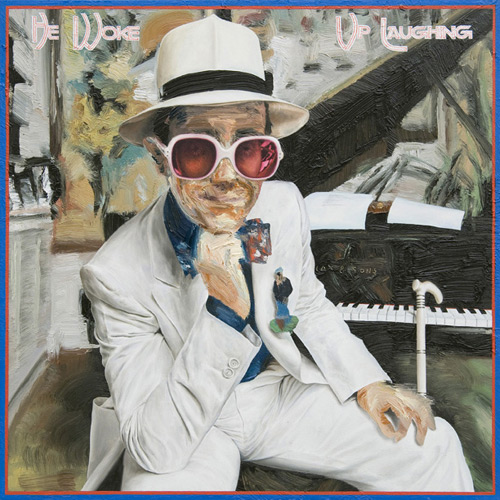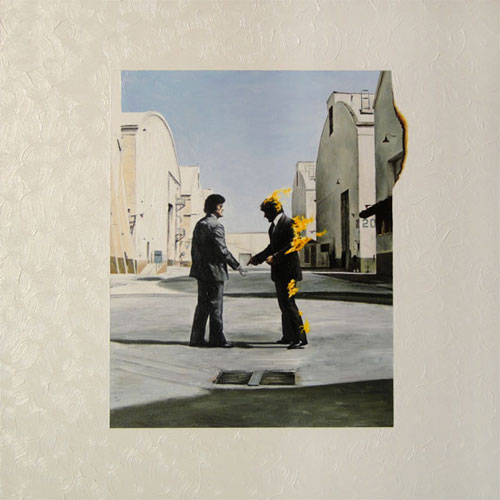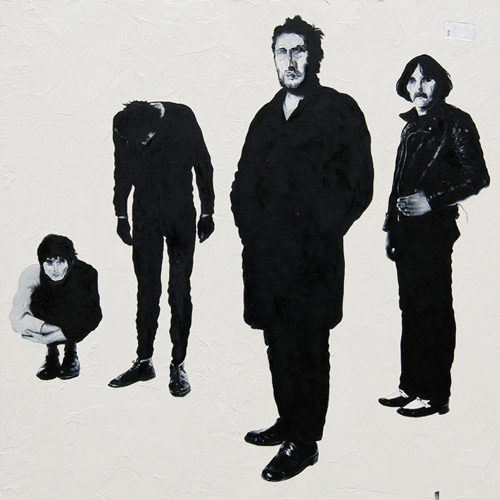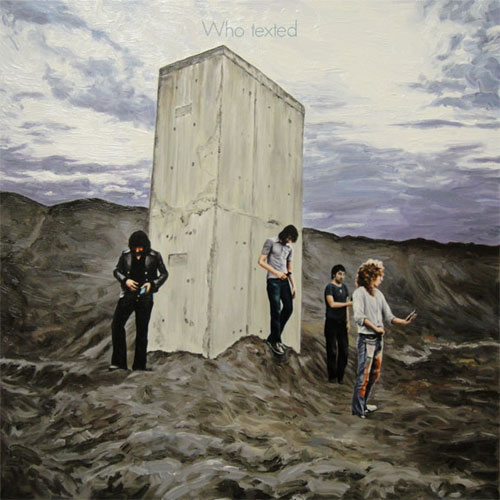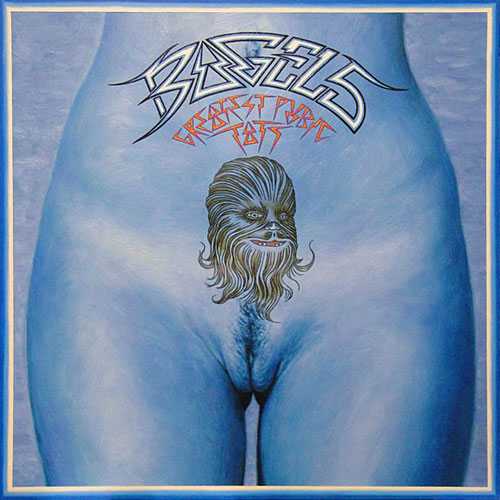Following on from our recent studio visit with Eric White, we put some questions to the Brooklyn based painter ahead of his New York solo show “LP” at Sloan Fine Art. AM thought that the concept he had behind the work was captivating – reworked album covers that carried an influence for the artist before he got his first CD player back in 1983 – all in a 12 inch square format, of course. This is Eric’s first NYC solo since the phenomenal “Who Are Parents?” at Earl McGrath Gallery back in 2004.
With the Fall schedule now hitting full swing, and a wealth of quality exhibitions opening recently, this is one show you definitely should not miss before it closes this weekend.
Read on for our interview after the jump.
Arrested Motion (AM): We think that your solo exhibition “LP” is a great concept for a show. You’ve chosen to re-invent album covers as the subject matter. Were the albums you chose special for you aurally, visually, or a combination of both?
Eric White (EW): This series started with a dream that I had where I was standing in a record store flipping through vinyl and came across that iconic Elton John Greatest Hits cover. At first it looked exactly like the real thing, but on closer inspection I realized he had assholes for eyes and I woke up laughing.
I was working on a European show and having a real creative block and struggling with what to make. I spent a couple days just sitting in the studio not productive at all and it occurred to me that maybe it was time to pursue the concept.
So it started with that piece, and from there it was a range of sources – favorites from my own collection, ones with nostalgic significance, purely aesthetic choices, albums I’m sick of seeing everywhere and wanted to fuck with, suggestions from friends, etc. In fact, Jordin Isip suggested several that I ended up using, and even helped me with a couple concepts. There are a total of 24 works in the show and throughout this project several other ideas have come to me. If this series continues, which I think it will, I plan to tackle some of those I didn’t have time for with this show.
AM: We recognize most of the albums you’ve used, and there is a very broad range of musical styles ranging from one of our favourites “Bad Brains” to Elton John. Your musical tastes seem to be quite eclectic. Can you give us a breakdown of the albums used and why you chose to use them?
EW: My musical tastes are really eclectic and that isn’t wholly reflected in this particular group. It would have to be a much bigger show to cover all the bases, and in the end, things really started to lean towards rock. I started a few pieces that didn‘t make it into the show for various reasons including an obscure country album, and a few jazz and hip hop records. I also wanted to limit the choices by using no album released after I bought my first CD player, which was in 1983.
AM: Some of the faces represented in the paintings are heavily distorted, even disfigured. What is it that you are communicating to us with this aesthetic?
EW: Distortion of the figure has always been prominent in my work and I’m sure will continue to be, though it is toned down a lot from my earlier work. I think it stems from the idea of emotional incompleteness as well as a discomfort with this reality. I guess it represents the feeling of not fitting in and being out of sync with “normal” life.
AM: The new work seems to signal a change of direction for your work. Was this a fun project to work with? Was it refreshing to work outside of your more widely seen style?
EW: It‘s definitely a change of direction, and also an evolution of themes I‘ve been working with for years.
It was incredibly fun as well as liberating. Difficult and too technical at times, but overall, I’d say it‘s the most consistent fun I’ve had in the studio in a long time. It broke me out of a place where I felt stuck and gave me freedom and new tools for expressing things. I’ve always loved pop art and more conceptual work and with this stuff, I’ve finally found a way to bring those influences into the mix.
I’m very excited about it and it feels like a real breakthrough, which added to the enjoyment of creating the paintings. I understand that some people that are fans of my other work aren’t going to like it, and that’s ok. I needed to take this risk, and it will only strengthen work I do from this point forward.
AM: The “LP” show at Sloan Fine Art is accompanied by Daniel Davidson’s “Double Stuff” showing at the gallery. You’ve shown previously this year with Daniel at Galerie Magda Danysz in Paris. You guys must have some kind of connection. Or at least travel in the same circles?
EW: Yes, Daniel is one of my best friends and a very important and underrated artist. He also happens to be one of the funniest people I’ve ever met and I think his work reflects that. With “Double Stuff” I think Daniel took a real leap with his work and I’m thrilled to be showing alongside him.
AM: It looks like you have Paris as a regular passport stamp as you recently were involved in the Livestrong “Stages” exhibition at Galerie Emmanuel Perrotin , which pulled together a dazzling array of contemporary artists. We understand that both Lance Armstrong and Mark Parker are supporters and collectors of your work. Tell us a little about your beautiful painting, “Foyer” and how you came to be involved with the show?
EW: Yes, Mark and Lance have been incredibly supportive. I met them both through Jamie O’Shea who curated the Stages exhibition. My mother suffered from two bouts of oral cancer and has been in remission for 16 years. So, I was very happy to contribute to the Livestrong Foundation and their amazing work.
The painting itself is my interpretation of my mother’s experience with cancer and at the same time, a tribute to her strength and courage in overcoming it. I chose the title “Foyer” for a couple reasons. There is an entryway in the painting, and I saw it as a threshold between life before and after cancer. And, it was a French word and the piece was premiering in Paris, so it worked. And then after the show, I learned from a friend that in French, “Foyer” also means the epicenter of a disease. It blew my mind when she told me that, and it’s the kind of thing that I think goes beyond coincidence, and makes me wonder about other forces at work in the creative process. Mondrian said “The position of the artist is humble. He is essentially a channel.”
AM: We understand that you have lived in Brooklyn for 9 years or so, but we’ve not seen a New York solo show from you since the brilliant “Who Are Parents?” show back in 2004. How come it’s been so long between shows on the home turf?
EW: I have been consistently producing and showing, but it’s true that this will be my first New York solo show since then. I think there are a variety of reasons. In the past few years, I’ve bought and renovated an apartment, and shifted to working in a studio outside my home. All of that stuff takes time. But the bottom line is that I was struggling creatively and struggling with my identity within the context of the greater picture of the New York art world. I’ve come to terms with that in many ways and embarked on this body of work, which has been a pleasure and felt like real progress and appropriate for a solo show. I wanted to be really excited before showing in New York again, and with this work, I finally am.
I was working on the album paintings when Alix Sloan approached me and it just seemed like a good fit. She and I have been friends for years and have worked together extensively. It all just seemed to click in a really effortless and positive way.
AM: As a Brooklyn import, how important is your location to the work you make? How do you think that the work you produce might be different if you still lived in Ann Arbor or San Francisco?
EW: I’ve had to toughen up living in New York and I think my work has become stronger as a result. It’s pretty intense being an artist living here. The art world is small and competitive and it really challenges you make work you believe in and to stand by it.
AM: You are often included in discussion of the “second wave” of the pop surrealism movement. Are you happy to be part of this genre or do labels make you uncomfortable?
EW: Both. I am a bit uncomfortable with labels in general. Humans have such a desperate need to classify things and make them fit into existing paradigms, and I don’t really see a point to it in an artistic context, but I think I understand why we do it. I don’t exactly see this as a movement, and I don’t like the names for it or the stigma often attached to it, but I don’t spend much energy worrying about it. I am extremely grateful to have shown alongside a lot of great artists within such an unusually supportive community, and much of my success has come from my association with the group. Through it I’ve certainly grown as an artist, and have made lifelong friends, and we continue to encourage and support each other.
AM: Can you share with us how your creative process goes? Does it tend follow a typical pattern or does the inspiration for each piece steer the painting process in different directions?
EW: Specific to this body of work, I have some pretty rigid confines I’m working within. But, I still try to let the work develop as organically as possible and these paintings have flowed in a way that I’ve never experienced before. This series started with a bewildering, funny dream and I strove to recapture that essence in every piece. With some of these, I just stared at the existing cover for a while, and after a few minutes, an idea would simply materialize.
AM: Circles and clusters of circles feature prominently in your work. What significance do these forms have for you?
EW: The shape is infinite, perfect and organic, and I’ve always liked the juxtaposition of graphic elements with highly rendered imagery. In the paintings, they also signify overlapping realities and the idea that there are simultaneous planes of existence. Although we perceive time as linear, it is probably more circular.
AM: Mid century Hollywood starlets also seem to feature in some of your most iconic paintings. The texture that you put into the hair is magnificent. Can you explain your fascination, if that is the right word, with the subject matter?
EW: I think obsession would be more appropriate. I really love that imagery, love the films, and have a large collection of books on the subject. I find it endlessly inspiring and aesthetically compelling. And the Hollywood starlet to me represents an idealized mother figure. I’m very interested in the unconscious mind and the way infantile psychology figures in, and how decisions made before the age of two, invariably involving the mother, can determine the direction and scope of our entire lives. Also, metaphysically speaking, I think of the movie as an invented reality that I equate with the idea of this reality as an illusion projected by our consciousness. Heavy!
AM: Another instantly identifiable feature of an Eric White piece is the painting within a painting, as seen in works such as the “Collusion” series. Can you tell us how these paintings came about?
EW: The original collusion piece was a sort of amalgam of images that struck my fancy at the time, and that were interesting enough for me to spend the time painting in intricate detail. I didn’t plan that one out beforehand, I would find them one at a time and stick them in. That painting originally had a figure standing in the foreground, but in the end, I decided to flatten it out and have it simply be a painting of a wall of paintings, or actually a painting of a point of view, a portrait of a viewer’s view. The ones for the “Who Are Parents?” show were inspired by the original idea, and each piece was a tribute to one of my parents’ four marriages. So the images in each painting relate to or are symbolic of aspects of that specific relationship, and they represent me looking at myself experiencing those parental relationships.
AM: Your rather excellent monograph “It Feeds Itself” features a huge list of acknowledgements and a positively monumental list of people that have inspired you. Since the book was published, if you could add 10 more people to the list who would that be and for what reason?
EW: I have been adding all kinds of names to the list since that book was published, but I’ll stick with visual artists. Here are ten that I’m inspired by that I either didn’t know at the time, or forgot to include: Anna Conway, Mark Tansey, Ellen Gallagher, Martin Kippenberger, Neo Rauch, Kerry James Marshall, David Altmejd, Mike Kelley, Paul Pfeiffer Glenn Brown
AM: Following the “LP” show, can you tell us of any upcoming plans you have for the rest of this year and next?
EW: First I plan to sleep for a while. Then I’ll go clean my studio and get back to it. I’m in two museum shows in Italy and Spain in the next few months, and I’ve got some commissions to take care of, some of which are LP related. There’s a group show in New York in the spring for which I plan to do a 16 foot wide painting, and then I’ll begin work on a concept I’ve been thinking about for years and which I’m really looking forward to exploring.
AM: Many thanks for taking to time to talk to us Eric. We wish you every success with the new show!
EW: Thank you!



